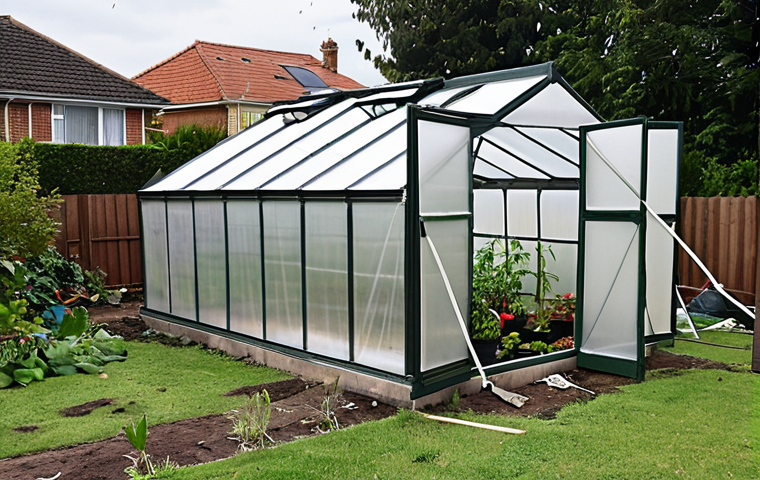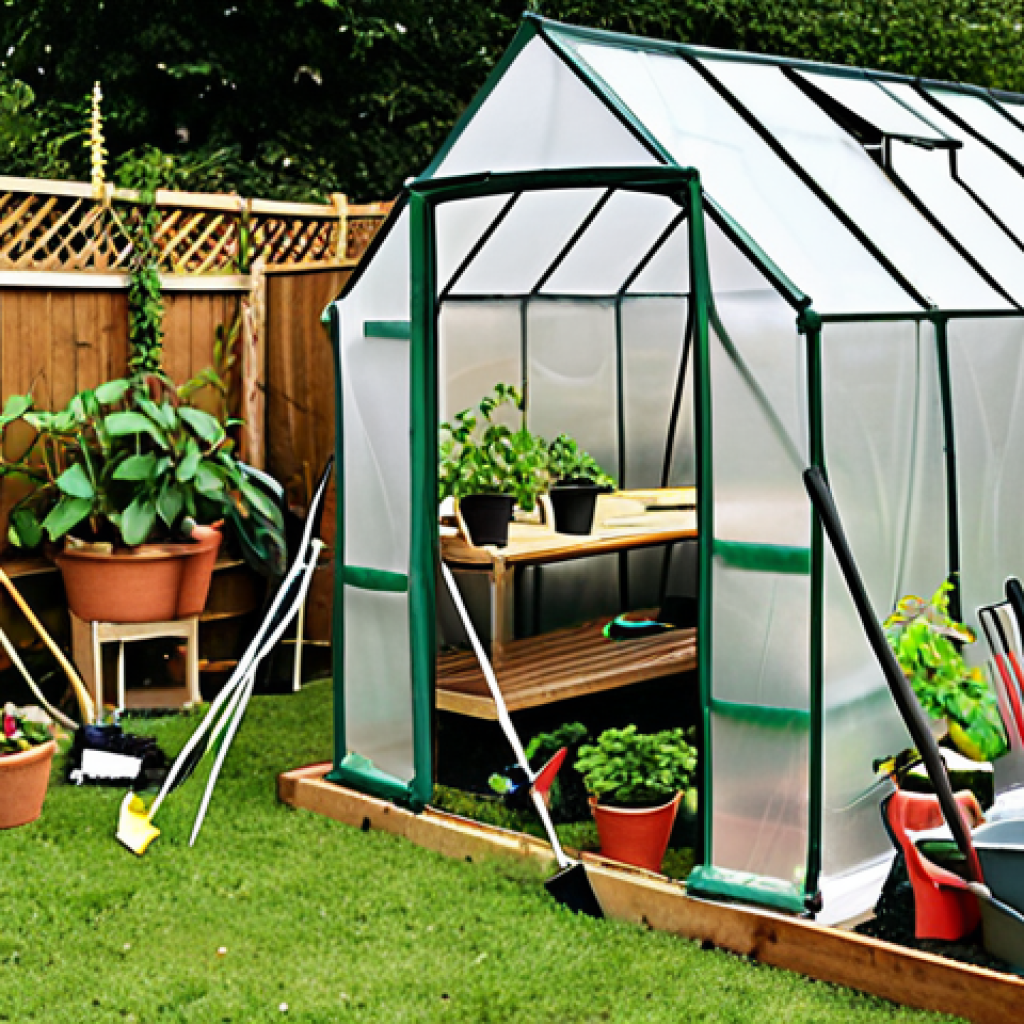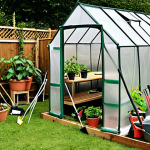Thinking of extending your growing season and protecting your precious plants? A pop-up greenhouse, especially a tent-style one, might just be the ticket.
I’ve been looking into them myself, and they seem like a fantastic way to get a head start on spring planting or keep those tomatoes ripening well into fall.
But, like anything, there are upsides and downsides to consider. It’s a bit like deciding between a quick trip to the farmer’s market versus the long-term commitment of actually growing your own food, the convenience versus the investment.
Let’s dive into what makes these mini-greenhouses tick and whether they’re right for your gardening needs. Let’s delve in to know more accurately!
Embracing the Extended Growing Season: The Magic of Pop-Up Greenhouses

Early Bird Gets the Garden Worm
One of the biggest advantages I’ve found in considering a pop-up greenhouse is the ability to jumpstart your gardening season. Living in a region with unpredictable springs, getting plants in the ground early can be a real gamble. A pop-up greenhouse acts like a cozy little incubator, allowing you to start seeds or transplant seedlings weeks before you normally could. I remember one year, trying to get my tomatoes going outdoors, only to have a late frost wipe them all out. With a pop-up greenhouse, those delicate seedlings would have been safe and sound, developing a robust root system ready to take on the summer heat. This isn’t just about getting a head start; it’s about increasing your chances of a successful harvest.
Shielding Plants from the Elements
It’s not just the cold that can wreak havoc on a garden. Intense sun, heavy rain, and strong winds can all stress plants and stunt their growth. A pop-up greenhouse provides a protective barrier against these harsh elements. I’ve seen firsthand how a sudden hailstorm can decimate a row of young lettuce plants. A greenhouse, even a temporary one, can offer a vital shield. Plus, by controlling the environment, you can reduce the risk of certain diseases and pests that thrive in wet or humid conditions. Think of it as a personal plant bodyguard, keeping your green companions safe and sound.
Unveiling the Dark Side: Challenges of Pop-Up Greenhouses
The Temperature Tango: Managing Heat and Humidity
One of the trickiest aspects of using a pop-up greenhouse is managing the internal temperature and humidity. On sunny days, these structures can heat up rapidly, creating a sauna-like environment that can be detrimental to plants. I recall reading about a gardener who accidentally cooked their entire crop of peppers by forgetting to ventilate their greenhouse on a warm afternoon. Proper ventilation is crucial, and it often requires constant monitoring and adjustment. You’ll also need to be mindful of humidity levels, as excessive moisture can lead to fungal diseases. It’s a delicate balancing act that requires attention and experience.
Durability Dilemmas: Weathering the Storm
Pop-up greenhouses, especially the more affordable ones, aren’t known for their exceptional durability. Strong winds can easily topple them, and heavy snow can cause the frames to collapse. I’ve seen videos online of greenhouses being swept away like kites in a storm. Choosing a greenhouse with a sturdy frame and anchoring it securely to the ground is essential, but even then, you might need to take it down during severe weather. It’s a trade-off between convenience and robustness.
Space Considerations: Making the Most of Your Garden Real Estate
Assessing Your Available Area
Before you rush out to buy a pop-up greenhouse, take a good look at your available garden space. These structures can take up more room than you might think, and you’ll need to ensure you have a level surface for placement. I’ve seen people try to squeeze greenhouses into tight corners, only to realize they can’t access them easily for watering and maintenance. Consider the size of your plants and the amount of sunlight the location receives throughout the day. It’s all about finding the right balance between space and sunlight.
Portability Perks: Moving with the Seasons
One of the appealing aspects of pop-up greenhouses is their portability. Unlike permanent structures, you can easily move them around your garden as needed. This is particularly useful if you want to follow the sun or protect plants from specific weather conditions. I once used a small pop-up greenhouse to shield my herbs from a late-season frost, and it made all the difference. The ability to relocate your greenhouse offers a level of flexibility that permanent structures simply can’t match.
Cost-Benefit Analysis: Is a Pop-Up Greenhouse Right for You?
Budget-Friendly Gardening
Pop-up greenhouses are generally more affordable than traditional greenhouses, making them an attractive option for budget-conscious gardeners. However, it’s essential to consider the long-term costs. Cheaper models might need to be replaced more frequently due to wear and tear, and you might need to invest in additional accessories like ventilation fans or shade cloths. I’ve learned that it’s often better to spend a little more upfront on a higher-quality greenhouse that will last longer and perform better.
Weighing the Pros and Cons
Ultimately, the decision of whether or not to invest in a pop-up greenhouse depends on your individual needs and circumstances. Consider the climate in your area, the types of plants you want to grow, and the amount of time and effort you’re willing to invest. I recommend researching different models, reading reviews, and talking to other gardeners who have experience with pop-up greenhouses. It’s all about making an informed decision that aligns with your gardening goals.
Assembly Adventures: Setting Up Your Pop-Up Greenhouse
Decoding the Instructions
Let’s be honest, assembling anything from flat-pack furniture to garden equipment can be a frustrating experience. Pop-up greenhouses are no exception. I’ve heard horror stories of tangled poles, missing pieces, and instructions that seem to be written in a foreign language. Before you even open the box, take a deep breath and set aside some time. Lay out all the components, read the instructions carefully (multiple times, if necessary), and don’t be afraid to enlist a friend for help. A little patience and preparation can go a long way.
Anchoring for Stability
Once you’ve managed to assemble your pop-up greenhouse, the next crucial step is anchoring it securely to the ground. As I mentioned earlier, these structures can be vulnerable to wind, so proper anchoring is essential. Most greenhouses come with stakes or ropes for this purpose, but you might want to consider additional measures, such as using sandbags or concrete blocks. I’ve seen people get creative with their anchoring methods, using everything from old tires to repurposed bricks. The key is to ensure that your greenhouse can withstand a strong gust of wind without taking flight.
Beyond the Basics: Maximizing Your Pop-Up Greenhouse Potential
Adding Ventilation and Shade
To create the optimal growing environment inside your pop-up greenhouse, you’ll likely need to add ventilation and shade. As I mentioned earlier, greenhouses can heat up quickly, so proper ventilation is crucial. You can achieve this by opening windows or vents, or by installing a small fan. Shade cloths can also help to reduce the amount of sunlight that enters the greenhouse, preventing your plants from getting scorched. I’ve found that a combination of ventilation and shade works best, allowing me to maintain a consistent temperature and humidity level.
Optimizing Soil and Watering
The success of your pop-up greenhouse garden also depends on the quality of your soil and watering practices. Choose a well-draining soil mix that is appropriate for the types of plants you’re growing. Water regularly, but avoid overwatering, as this can lead to root rot. I recommend using a drip irrigation system or a watering can with a long spout to avoid wetting the foliage. You can also add fertilizer to the soil to provide your plants with the nutrients they need to thrive. It’s all about creating a healthy and balanced growing medium.
Troubleshooting Common Pop-Up Greenhouse Problems
Dealing with Pests and Diseases
Even in a controlled environment like a pop-up greenhouse, pests and diseases can still be a problem. Regularly inspect your plants for signs of infestation or disease, such as aphids, whiteflies, or powdery mildew. If you spot any problems, take action immediately. There are many organic pest control and disease management methods you can use, such as spraying with neem oil or insecticidal soap. I’ve found that prevention is the best approach, so I try to maintain a clean and healthy growing environment.
Repairing Tears and Damage
Over time, the plastic covering of your pop-up greenhouse might develop tears or holes. These can be caused by wind, sun, or simply wear and tear. Fortunately, it’s usually possible to repair these tears with duct tape or patching material. You can also purchase replacement covers for some models. I recommend keeping a repair kit on hand so you can quickly address any damage that occurs. A little maintenance can extend the life of your greenhouse and keep your plants protected.
| Feature | Pros | Cons |
|---|---|---|
| Cost | More affordable than permanent greenhouses | Cheaper models may require frequent replacement |
| Portability | Easy to move around the garden | May need to be taken down during severe weather |
| Ease of Assembly | Relatively easy to set up | Instructions can be confusing |
| Climate Control | Extends growing season; protects from elements | Requires careful monitoring of temperature and humidity |
| Durability | Provides some protection from wind and rain | Can be damaged by strong winds or heavy snow |
Embracing the possibility of growing your own food and flowers, even in unpredictable climates, can be truly rewarding. While pop-up greenhouses present challenges, the ability to extend your growing season and protect your precious plants makes them a worthwhile investment for many gardening enthusiasts.
So, why not give it a try and experience the joys of nurturing your own little green oasis?
Wrapping Up
Ultimately, the decision to use a pop-up greenhouse boils down to your personal gardening aspirations and willingness to manage its quirks. It’s not a perfect solution, but it can be a game-changer for many gardeners.
With proper planning, maintenance, and a dash of horticultural intuition, a pop-up greenhouse can be your secret weapon in the quest for a thriving garden.
Happy gardening!
Handy Tips and Tricks
1. Location, Location, Location: Always position your pop-up greenhouse in a spot that gets plenty of sunlight, ideally facing south or east in the Northern Hemisphere. Avoid areas that are prone to strong winds or waterlogging. Make sure the placement is optimized for the sun exposure in your climate.
2. Ventilation is Key: Invest in a small battery-operated fan to circulate air inside the greenhouse, especially on hot days. Stagnant air can lead to disease and pest problems. It can also help to regulate the humidity levels within.
3. Water Wisely: Use a watering can or soaker hose to water your plants gently, avoiding splashing water on the leaves. Water early in the day to allow the foliage to dry before nightfall. Consider rain barrels for efficient irrigation, as well.
4. Pest Patrol: Regularly inspect your plants for signs of pests, and take action immediately. Use organic pest control methods like insecticidal soap or neem oil. Companion planting can naturally deter many common pests. Marigolds are a great option.
5. Weather Watch: Always keep an eye on the weather forecast and take precautions to protect your greenhouse from storms. Anchor it securely, and consider taking it down if severe weather is imminent.
Key Takeaways
A pop-up greenhouse can significantly extend your growing season, allowing you to start seeds early and protect plants from harsh weather. However, temperature management is crucial, requiring constant monitoring and ventilation.
These greenhouses are relatively easy to assemble but can be vulnerable to strong winds and snow. Proper anchoring is essential for stability. Consider the long-term costs and maintenance requirements when making your decision.
Ultimately, a pop-up greenhouse offers an affordable and flexible way to create a protected growing environment, but it requires some commitment to ensure its success.
Frequently Asked Questions (FAQ) 📖
Q: How easy are pop-up greenhouses to actually set up and take down, especially when the weather is being a real pain?
A: Okay, so I’ve wrestled with my fair share of these things, and here’s the scoop. When it’s a calm, sunny day, popping one of these up is a breeze – literally five minutes.
But, try doing it when it’s windy, raining, or both? That’s when you might wish you had a third hand or a really patient friend. The wind can turn that greenhouse into a giant kite!
Taking it down is usually easier, but still, make sure you’re not battling the elements alone. I’d recommend practicing once in good weather, so you aren’t completely flustered when you need it most.
And trust me, those stakes they give you? Sometimes you might need to get some heavier-duty ones, especially if your ground is soft or the wind is a regular visitor.
Q: Will a pop-up greenhouse really keep my plants warm enough in the winter or protect them from a sudden late frost?
A: Honestly, it’s not a magic bullet. A pop-up greenhouse will definitely offer some protection – I’ve seen it keep my peppers alive longer into the fall, providing a buffer of a few degrees.
But if you’re talking about a hard freeze, like those nights where it dips way below freezing, you’ll need extra measures. Think of it like wearing a light jacket versus a parka in the dead of winter.
For those really cold snaps, consider adding a small electric heater inside (make sure it’s rated for outdoor use and safe!), wrapping the greenhouse in bubble wrap for extra insulation, or even bringing the most vulnerable plants indoors.
I learned the hard way one year when I lost a bunch of herbs to a surprise frost; now, I don’t take any chances!
Q: Are these pop-up greenhouses durable enough to withstand a season’s worth of use, or are they more of a one-and-done kind of deal?
A: That really depends on the quality of the greenhouse and how well you take care of it. I’ve bought some cheaper ones that ripped after just a few months, especially if they’re constantly exposed to strong winds or direct sunlight.
The UV rays can really do a number on the plastic! But I’ve also had a more expensive one that lasted me two full seasons before the zippers started to give out.
My advice? Read the reviews before you buy. Look for greenhouses with reinforced seams, UV protection, and sturdy zippers.
Also, take the time to properly anchor it to the ground, and when you’re not using it, store it in a cool, dry place. Treat it right, and it can definitely last you more than just one season.
Think of it like your favorite camping tent – a little care goes a long way.
📚 References
Wikipedia Encyclopedia
구글 검색 결과
구글 검색 결과
구글 검색 결과
구글 검색 결과
구글 검색 결과

